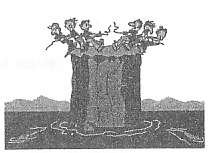 TRIZ
Textbooks: CID Course for Children, 3-1G1 TRIZ
Textbooks: CID Course for Children, 3-1G1 |
  
|
Topic 1.
Method of Solving Problems
(Contradictions,
Ideality, and Resources) |
Planet
of Unsolved Misteries:
Course of Creative Imagination
Development (CID),
3rd Grade, 1st Semester,
Methodical Guide-Book |
Natalia
V. Rubina, 1999 [published
in Russian]
English
translation by Irina Dolina,
Jun. 3, 2001
Technical
Editing by Toru Nakagawa, Dec.
8, 2001 |
Posted
in this "TRIZ Home Page in Japan" in English on Dec. 17, 2001 under the
permission of the Author.
(C) N.V. Rubina,
I. Dolina, and T. Nakagawa 2001 |
|
Topic
1. Method of Solving Problems
(Contradictions,
Ideality, and Resources) |
Lesson 1.
Workbook
1. Warming-up
“Card index to the CID lessons for the third grade”.
3. Introduction to the lesson

-
Author:
-
Topic: Ideality and resources.
-
Content of the problem: In order to leave his uninhabited island,
Robinson Crusoe has been cutting a huge tree for a month. It took
several months to make a boat of this tree. All the time Robinson
tried not to think about the way how he was going to put this boat in the
water. When the boat was ready, it turned to be big, reliable, and
ready to sail across the ocean; and then he couldn’t put this thought off
any more. The attempts to move the boat proved to be fruitless.
Robinson tried to act “vise versa” – to bring the water to the boat.
But when he calculated the amount of work he had to do, he gave up this
idea. What can be done in this situation?
-
Solution: – ?
-
Source of information:
4. Main topic
This problem is often used to teach
a method of brain storming. The brain storming is the most popular
method of psychological stimulation of creative thinking. At the
lessons, devoted to the methods of creative thinking stimulation, we didn’t
dwell upon this method on purpose. However, the rules of holding
the brain storming helped to find a way of solving problems, obtaining
and implementing fantastic ideas. “It has been noted long ago that
a critical attitude and even a fear of being criticized is an substantial
obstacle in the process of creative thinking. Any new idea might
be wrong, and if the author is afraid of being criticized, he wouldn’t
suggest an unverified idea. In this case many potentially good ideas
are lost. This circumstance became the starting point for creating
a new method of organizing the process of thinking. In order to remove
the obstacle, caused by the fear of criticism, it was proposed to divide
in time the processes of putting forward ideas and their critical evaluation.
Both of them should be conducted by different people. The method,
called the brain storming, was put forward by A. Osborne.
In the USA the interest for the brain stroming
was decreasing after 8-10 years of its emerging. It was pushed out
by synectics, which is its further development. In GDR the brain
storming was used under the title of “the conference of ideas”. Though
the expediency of using the brain stroming was proved, the initial expectations
for this method were not realized.
The best results of the brain storming are achieved
while considering the problems of organizational character (for example,
to find a new use for the produced production, to find a new form of advertising,
etc.) or the relatively simple inventive problems”. ("Theory and
practice of solving inventive problems”, edited by G. S. Altshuller, Gorky,
1976, pp. 40-43.)
Robinson Crusoe was a tireless
inventor. We have already mentioned his amazing adventures, studying
the topic of “Resources”. We are familiar with the methods, which
will help us to find a solution of the problems that even the brave explorer
couldn’t solve.
In “Card index to the CID lessons for the
third grade”, there are a selection of Robinson’s problems and some recommendations
concerning their solving.
1. Your ideas about solving this problem:
____________________________________________________________
____________________________________________________________
____________________________________________________________
____________________________________________________________
2. Choose the best:
____________________________________________________________
____________________________________________________________
On the basis of these ideas articulate the contradictions.
If
_______________________________________________________
Then (+) _______________________________________________________
But (–) ____________________________________________________________
Find the opposite properties:
_______________ should be ____________, in order to __________
and should be ____________, in order to __________.
Articulate the ideal solution:
__________________________________________________________
Which resources are there for the solution of this problem?
__________________________________________________________
Solution:
__________________________________________________________
__________________________________________________________
__________________________________________________________
5. Psycho-technical and developing games
In ”Card index to the CID lessons for the third
grade” there are games on self-regulation, on developing memory and attention,
etc.
7. Sum up
Homework.
One of Robinson’s problems (“Card index to the CID lessons
for the third grade).
Workbook
Lesson 2
1. Warm-up
(Card index to the CID lesson for the third grade).
2. Homework
Considering the homework problem.
4. Main topic
Contradictions emerge not only in the technical
systems. Problems and conflicts emerging between people. We
can try to solve problems and conflicts, arising between people, by using
the methods and rules, already known to us – ideality, maximum use of resources,
making things upside down, speeding up - slowing down, and others.
The problems, arising during interaction between people, are called in
TRIZ inter-personal. Today we’ll consider the fairy problem.
The main characters of this conflict are fairy tale characters, but I am
sure, you will be able to remember certain people, whose behavior reminds
us of the characters of this problem.
Problem 2. "About Kolobok" (Small round loaf)
This is the Kolobok that was baked
with such effort by an old woman who was sitting at the window and looking
through the book “Russian Folk Tales”. Kolobok didn’t go to school,
and therefore he couldn’t read the book. However, he remembered very
well those whom he was going to meet to on a forest path. All the
animals seemed very nice to him. Only one of them – red and fluffy
– had very cunning eyes and his teeth were shining. Kolobok realized
that the main danger for him was coming from this particular animal and
decided to get ready for this meeting. How can Kolobok save himself
from the cunning Fox?
The first possible solution: to feed
the Fox in advance so that he would not be hungry.
Contradiction:
If
Kolobok sits on the Fox’s nose,
Then (+) the Fox will hear the song,
But (–) can
eat Kolobok.
To sing in a microphone very loudly, so that
the whole forest could hear (additional (+) other animals will hear and
won’t let Kolobok get into trouble.)
If
to fight with the Fox,
Then (+) it is possible to defend oneself,
But (–) Kolobok is weak.
IFR (Ideal Final Result):
The Fox refuses to eat Kolobok
by
himself.
Contradiction:
Kolobok must jump on the Fox’s nose in order to let the
Fox hear his song,
and Kolobok must not jump on the Fox’s nose, in order
not to be eaten by the Fox.
Kolobok must be delicious, so that the old man and the
old woman liked him,
and he mustn’t be delicious, not to be tasteful for the
Fox.
This is Kolobok with lemon.
Resources:
Kolobok, the song, the Fox’s taste.
Methods of solving contradictions:
In time: “Let’s buy some sour cream
at first, with the sour cream it is more delicious”.
In space: but not in the forest
System – subsystem: a part of Kolobok is delicious,
another part is undelicious.
System – supersystem: Kolobok + pepper, nails and
others.
System – antisystem: Kolobok voluntarily
jumps on the Fox’s nose, taking with him an iron circle.
In “Card index to the CID lessons for the third grade”
there is a selection of the problems from various fields of knowledge.
5. Psycho-technical and developing games
In “Card index to the CID lessons for the third
grade” there are games on self-regulation, on developing of memory and
attention, etc.
7. Sum up
Every day we face contradictions and solve
them somehow. Good, nice, strong solutions emerge when a contradiction
is solved with the maximum use of resources of the system where this problem
appeared, and with minimum changing of this system. This means the
solution is close to ideality (you remember, it removes "–" by itself while
preserving "+"). Every time solving a contradiction, we make a small
discovery, devising a new invention.
Homework.
Watch the people surrounding you and try to
articulate inter-personal problems. Write them down on the cards
in the end of your workbook.
Last updated
on Dec. 17, 2001. Access point: Editor:
nakagawa@utc.osaka-gu.ac.jp
